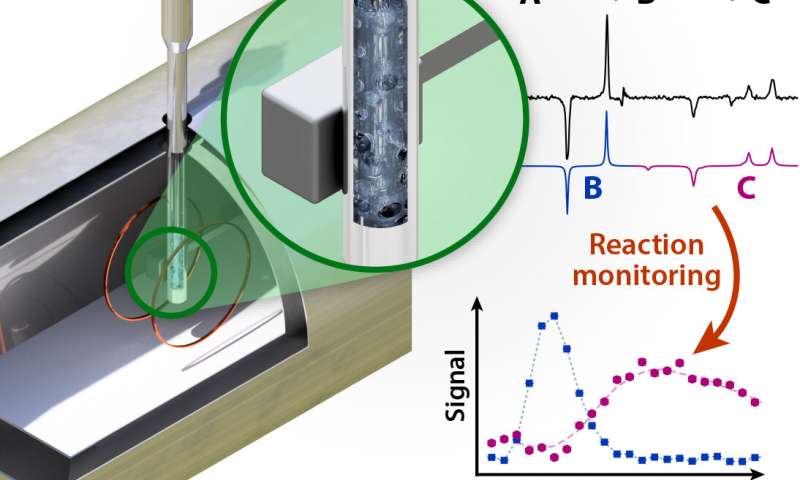HOME
New nuclear magnetic resonance method enables monitoring of chemical reactions in metal containers

Chemical reaction monitoring via zero-field nuclear magnetic resonance (NMR): A sequential hydrogenation reaction (A–>B–>C) is initiated inside a metal reactor inserted into a magnetically shielded enclosure. The NMR spectrum of the heterogeneous (gas/liquid) reaction is recorded with an atomic magnetometer positioned next to the reactor. Analysis of the spectra acquired during the course of the reaction reveals the changing concentrations of compounds B and C. Credit: John W. Blanchard
Nuclear magnetic resonance (NMR) is employed in a wide range of applications. In chemistry, nuclear magnetic resonance spectroscopy is in standard use for the purposes of analysis, while in the medical field, magnetic resonance imaging (MRI) is used to see structures and metabolism in the body. Scientists at Johannes Gutenberg University Mainz (JGU) and the Helmholtz Institute Mainz (HIM), working in collaboration with visiting researchers from Novosibirsk in Russia, have developed a new method of observing chemical reactions.
For this purpose they use NMR spectroscopy, but with an unusual twist: There is no magnetic field. "This technique has two advantages. For a start, we are able to analyze samples in metal containers and, at the same time, we can examine more complex substances made up of different types of components," said Professor Dmitry Budker, head of the Mainz-based group. "We think our concept could be extremely useful when it comes to practical applications."
As a chemical technique, NMR spectroscopy is used to analyze the composition of substances and to determine their structures. High-field NMR is frequently used, which allows the nondestructive examination of samples. However, this method cannot be used to observe chemical reactions in metal containers because the metal acts as a shield, preventing penetration of the relatively high frequencies. For this reason, NMR sample containers are typically made of glass, quartz, plastic, or ceramic. Furthermore, high-field NMR spectra of heterogeneous samples containing more than one component tend to be poor. There are more advanced concepts but these often have the drawback that they do not make in situ monitoring of reactions possible.
News Source